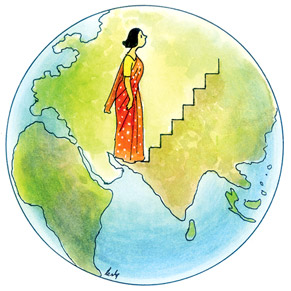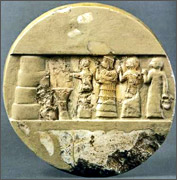|

Women’s status, an ‘Asian enigma’
Dr Dileni GUNEWARDENA
Reducing child underweight is listed as a key target to measure
progress toward achieving the first of the Millennium Development Goals.
A puzzling feature that emerges from international and inter-regional
comparisons of child malnutrition data is that child malnutrition rates
in South Asia are much higher than in Sub-Saharan Africa, while infant
and child mortality figures in South Asia are much lower compared to the
latter region.
The title of an influential commentary article by Ramalingaswamy,
Jonsson and Rohde (1996) led to the naming of the phenomenon as the
‘Asian Enigma.’ In this article, the authors examine and dismiss
potential explanations of this enigma: Asia’s poverty, inequality, poor
agricultural performance, government neglect and the predominantly
vegetarian South Asian diet cannot be the cause of higher malnutrition
rates in Asia than in Africa- because Africa fares as badly-or often
much worse than Asia-in terms of all of these factors.
 Two other more persuasive factors are also considered: Africa’s
higher child death rates and inappropriate international growth
standards for Asian countries. Could it be a question of the survival of
the fittest? Africa’s higher child death rates mean that weaker children
die and stronger children survive-hence malnutrition is lower? Recent
studies took this into account and found that while accounting for this
may reduce the gap in malnutrition between South Asia and Sub-Saharan
Africa, it does not do so by very much. Two other more persuasive factors are also considered: Africa’s
higher child death rates and inappropriate international growth
standards for Asian countries. Could it be a question of the survival of
the fittest? Africa’s higher child death rates mean that weaker children
die and stronger children survive-hence malnutrition is lower? Recent
studies took this into account and found that while accounting for this
may reduce the gap in malnutrition between South Asia and Sub-Saharan
Africa, it does not do so by very much.
The debate about inappropriate growth standards is now considered
dead. Studies of children in healthy environments found that well-fed
and well-cared for children did just as well whether they were born in
Nairobi, New Delhi or New York.
What the authors argue persuasively is that the key to South Asia’s
high rates of child malnutrition is to be found in low birth weights of
children and high level of anaemia prevalent among South Asian women,
compared to children and women in Sub-Saharan Africa. The authors argue
that these factors are linked to differences in women’s status in these
societies.
To quote “But why should low birth weight be so much more common in
South Asia? Low birth weight indicates that the infant was malnourished
in the womb and/or that the mother was malnourished during her own
infancy, childhood, adolescence, and pregnancy.
The proportion of babies born with low birth weight therefore
reflects the condition of women, and particularly their health and
nutrition, not only during pregnancy but over the whole of their
childhood and young lives. During the pregnancy itself, the average
woman should gain about 10 kilos in weight. What evidence there is
suggests that most women in Africa probably come close to that figure,
whereas most women in South Asia probably gain little more than 5
kilos.”
“The incidence of low birth weight is one clear marker of this
process. Another is the level of anaemia. About 40% of women in
sub-Saharan Africa suffer from iron
deficiency anaemia, as opposed to approximately 60% of women in South
Asia, a proportion that rises to 75% in pregnancy (and a staggering 83%
in India).”
“In short, the poor care that is afforded to girls and women by their
husbands and by elders is the first major reason for levels of child
malnutrition that are markedly higher in South Asia than anywhere else
in the world.”
Child malnutrition in Sri Lanka exemplifies the Asian enigma.
Although at 21% in 2007, child underweight rates in Sri Lanka are lower
than other countries in the region, they are higher than in such
unexpected countries as Haiti and Rwanda, and many other African
countries and much higher than would be expected given its level of per
capita income and infant mortality rate.
An international comparison of child malnutrition rates relative to
per capita income, based on cross- sectional data for 2002 on 113 low-
and middle-income countries UNDP 2002), shows that Sri Lanka has a
significantly higher child underweight rate than would be expected on
the basis of its per capita GDP. This is in sharp contrast to Sri
Lanka’s celebrated performance on other social indicators, such as
primary education enrolment, adult literacy, infant mortality and life
expectancy, where the country performs well above the levels that would
normally be expected at its level of per capita income.
Indeed, Sri Lanka has a child underweight rate that may be three
times as high as what would be expected of a country with its level of
infant mortality.
There is thus a big disconnect between Sri Lanka’s performance on
child health and its performance on child malnutrition. This
incongruence is difficult to understand as most factors that are
associated with low rates of infant and child mortality (for example,
delivery and utilization of high-quality health services, high female
literacy, and good hygiene and health practices) typically also
influence child malnutrition rates.
What can be done? In Sri Lanka, much of what can be done directly has
been done. This may explain why we are in a better situation than India
or Bangladesh. Ante-natal care is quite good in most parts of the
country.
 Maternal nutritional interventions (Thriposha) are given. The right
nutrition education messages are given. Besides, immediate pre-natal
care and nutrition may not help very much if the problem is one of
chronic malnutrition among women of child-bearing age. The disaggregated
picture points to a clear association between poverty and child under
nutrition as well as between ethnicity and child under nutrition. This
is evident in the most recent district level statistics on child
malnutrition available on the Department of Census and Statistics
website.(http://www.statistics.gov.lk/MDG/Indicators%20New/4.pdf ). Maternal nutritional interventions (Thriposha) are given. The right
nutrition education messages are given. Besides, immediate pre-natal
care and nutrition may not help very much if the problem is one of
chronic malnutrition among women of child-bearing age. The disaggregated
picture points to a clear association between poverty and child under
nutrition as well as between ethnicity and child under nutrition. This
is evident in the most recent district level statistics on child
malnutrition available on the Department of Census and Statistics
website.(http://www.statistics.gov.lk/MDG/Indicators%20New/4.pdf ).
At the district level (Badulla, Trincomalee and Batticaloa with
higher proportions of ethnic Tamils have the highest incidence of
moderate child undernutrition), and this is also true at the sector
level (estate sector malnutrition is much higher than urban or rural).
There is also some evidence for this at the household level
(Deolalikar, Aturupane and Gunewardena 2008, see
http://ideas.repec.org/p /unu/ wpaper/rp2008-53.html.) The information
from the census website indicates particularly that undernutrition among
ethnic Tamil children is not just restricted to estate areas.
The link between ethnicity and malnutrition is little explored. Does
the cause lie with service delivery (in the estates perhaps)? In
culture, where patriarchy is arguably stronger among Tamil communities?
In employment opportunities, where women must work because men cannot
find sufficient work to support their families? These are questions that
must be explored and addressed if Sri Lanka is to achieve progress in
relation to a significant target with respect to the MDG of eradicating
extreme poverty and hunger.
The writer is a senior lecturer in Economics, Department of Economics
and Statistics, University of Peradeniya.
Message from Enheduanna
Aditha DISSANAYAKE
If you search Google to find out the name of the world’s oldest
writer, you are bound to come across the name Enheduanna. Though there
were many anonymous scribes who wrote before Enheduanna, this “Ornament
of the Sky” was the first to write the author’s name on a piece of
written work. Revered as the most important religious person of the
time, (around 2300-2225 BC), Enheduanna was also the first author in
recorded history to write in the first person. So intricate was the
writing which often took the form of incantations to Inanna, the goddess
of love and war, scholars call Enheduanna the “Shakespeare of Sumerian
literature”.
 |
|
Enheduanna
disk |
End of the mystery. If you have not guessed it yet,yes, (though male
chauvinists may not wish to know), the world’s oldest writer is a woman.
The name, Enheduanna when translated into English means “The High
Priestess called Ornament of the Sky”. Did we too have such scholarly
“ornaments” in our midst in the days of yore? Did two nuns from India,
Sivala and Maharuha, write the earliest extant chronicle of our country,
the Dipavamsa? Unfortunately, no, even though it would have been good to
think this is so. Prof. Raj Somadeva, at the Post Graduate Institute of
Archeology, University of Kelaniya says there is no substantial evidence
to prove the Dipavamsa is the work of nuns.
For, considering the nature of the ancient chronicles the Dipavamsa
cannot belong merely to two authors. The apparent lack of uniformity,
the unevenness of style, incorrectness of language and metre and the
numerous repetitions all point to the fact that the book was written by
several authors.
Recorded literature
This explanation inevitably leads to a question. Why? Why do we not
have any form of recorded literature written by women in our history?
Though it has to be accepted that Enheduanna got the opportunity to
write her songs and claim she wrote them because she was the daughter of
a powerful king, King Sargon, who appointed her as the High Priestess of
the temple of Ur, didn’t we too have powerful kings with talented
daughters who could have written songs like Enheduanna’s Nin-me-sara?
Prof. Somadeva says one reason for this could have been the fact that
ours was an agriculture based society in which the male played the
dominant role. “Another reason is that those who were literate were
almost always the clergy the majority of whom were men. So it is natural
that they may not have paid much attention to women and children”.
Artistic talents
The situation though, is not as drastic as it may seem. “Even though
there are almost no literary evidence to prove the artistic talents of
women in the early days of civilization their contributions are present
in the folk songs and folk tales which are still present among us”
assures Prof. Somadeva , perhaps in a diplomatic move to appease ultra
sensitive feminists.
But what can never be reconciled is the unfair assumption held by
archaeologists and historians till recent times, that it was a man’s
world back in the Pleistocene days.
 |
|
Remains of
Enheduanna’s office |
The reason for this is that most of the artifacts that have come to
us from the last Ice Age were materials that can exist in the ground for
a long time. i.e bones and stones. It has been assumed that tools made
with stones and bones were used for the most part by men. As J.M
Adovasio, Olga Soffer and Jake Page state in the “Invisible Sex” “The
remains of materials used for the most part, it is assumed by women,
such as willow for making baskets and cordage for making bags and other
useful items, are plant remains and therefore preservationally fragile.
Things made of plants do not last very long in the ground except in
the most extraordinary circumstances, such as in extremely dry caves”.
The result: in the absence of evidence to prove the woman’s role in
prehistory it was assumed that man held centre stage.
Bigger role
“But this perspective of man as hunter in prehistoric times has now
changed” says Prof. Somadeva. Cultural anthropologists have now thrown
aside the assumption that men possessed the skill to bring down enormous
beasts to provide all the food needed for their families leaving the
women to play only a minor role in their day to day lives, as hard to
believe. “The ideological picture of Early Man the Mighty Hunter has now
changed. Its place has now been taken by the concept of woman the
gatherer, for women would have played an equal or far bigger role in
looking after their families than the men” says Prof. Somadeva. “The
berries and the yams gathered by the women would have sustained their
families as much as the meat brought in by the men”.
Archaeologists today tend not to look only for stone and bone tools
as they did in the past so that they will not miss whatever evidence
that may have survived to show the role women played in prehistoric
society. Yet, in spite of the effort to unearth hitherto unnoticed
material no woman has still been personally identified till 2.300BC.
Enter Enheduanna. Her epithet to the Goddess Inanna is a salutation
to all women of the past, present and future. “My lady, your greatness
is manifest”.
[email protected]
|



